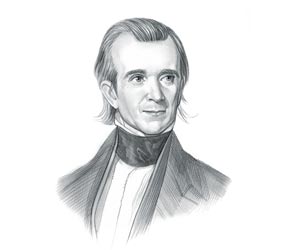|
The Wilmot Proviso opened the
issue of slavery to public debate and national politics
by avoiding the
1836 "Gag Rule".
What is a Proviso?
Definition of a Proviso: A proviso is an article or clause by
which a condition, amendment, precondition or stipulation is
introduced. A conditional stipulation that affects a proposal,
agreement, contract, law or grant. A proviso usually begins with the
word 'provided'.
What was the
Wilmot Proviso of 1846?
The Wilmot Proviso
was a proposal by Democratic representative David Wilmot (1814 -
1868) of Pennsylvania in response to President James Polk request to
Congress in August 1846 for $2 million to help him negotiate peace
and settle the boundary with Mexico. David Wilmot
attached his proposal, known as the Wilmot Proviso, to President
James K. Polk's funding measure.
What did the
Wilmot Proviso propose?
The
original text of Wilmot Proviso is as follows:
"Provided, That, as an express
and fundamental condition to the acquisition of any territory from
the Republic of Mexico
by the United States, by virtue of any treaty which may be negotiated
between them, and to the use by the Executive of the moneys herein
appropriated, neither slavery nor involuntary servitude shall ever
exist in any part of said territory,
except for crime, whereof the party shall first be duly convicted."
The Wilmot Proviso
was attached as an amendment to the $2million appropriations bill
and proposed: To ban
slavery in the territories acquired from Mexico, including
California
When was the
Wilmot Proviso introduced?
The amendment known as the Wilmot Proviso was introduced in the US
Congress on August 8,1846, just after the start of the
Mexican-American War that
began on April 25, 1846.
What was the Purpose of the
Wilmot Proviso?
The status of the territories regarding slavery had not been decided
by the beginning of the American-Mexican War. The purpose of the Wilmot Proviso
was to stipulate that none of the territory acquired in the Mexican
War should be open to slavery. David Wilmot and other angry
northerners felt that the entire Cabinet of James Polk and its
policies were dominated by pro-slavery supporters of the south and
the purpose of the Wilmot Proviso was therefore to voice the
anti-slavery views of the north.
The
First
Wilmot Proviso Amendment stalled in the Senate
Many had agreed
that Texas should be be a slave state and that
Oregon should be free state but the North believed
that California and Mexico should be a free state.
The amended appropriations bill, with the Wilmot
Proviso, was passed in the House of Representatives.
The north was more populous and therefore had more
Representatives in the House which enabled them to
pass the Wilmot Proviso. However, the law required
the approval of both houses of Congress before it
could be passed. It stalled in the Senate where the
South had greater representation.
The
Wilmot Proviso Amendment: The Gag Rule
The Wilmot Proviso had been stalled in the Senate
but it had managed to inject the controversial
slavery issue into the funding debate. Up to this
point the subject of slavery had been totally
avoided in Congress by the "Gag Rule". The
1836 Gag Rule had stated:
"All petitions, memorials,
resolutions, propositions, or papers, relating in any way, or to any
extent whatsoever, to the subject of slavery or the abolition of
slavery, shall, without being either printed or referred, be laid on
the table"
So by attaching
the Wilmot Proviso to the Funding Bill David Wilmot
had circumnavigated the "Gag Rule".
Defeat of the Second
Wilmot Proviso Amendment
When the next
Congress convened, a new appropriations bill for $3
million was presented by President James Polk and
the Wilmot Proviso was again attached to the bill.
The House of Representatives again passed the bill
and this time the Senate was forced to consider the
proposal. Under the leadership of Senator John C.
Calhoun, and other pro-slavery senators, the Senate
refused to accept the second Wilmot Proviso,
approving the funds for negotiations in the
American-Mexican War without the proviso.
The
Wilmot Proviso Impact and Effects
The
impact and effects of the Wilmot Proviso were:
|

